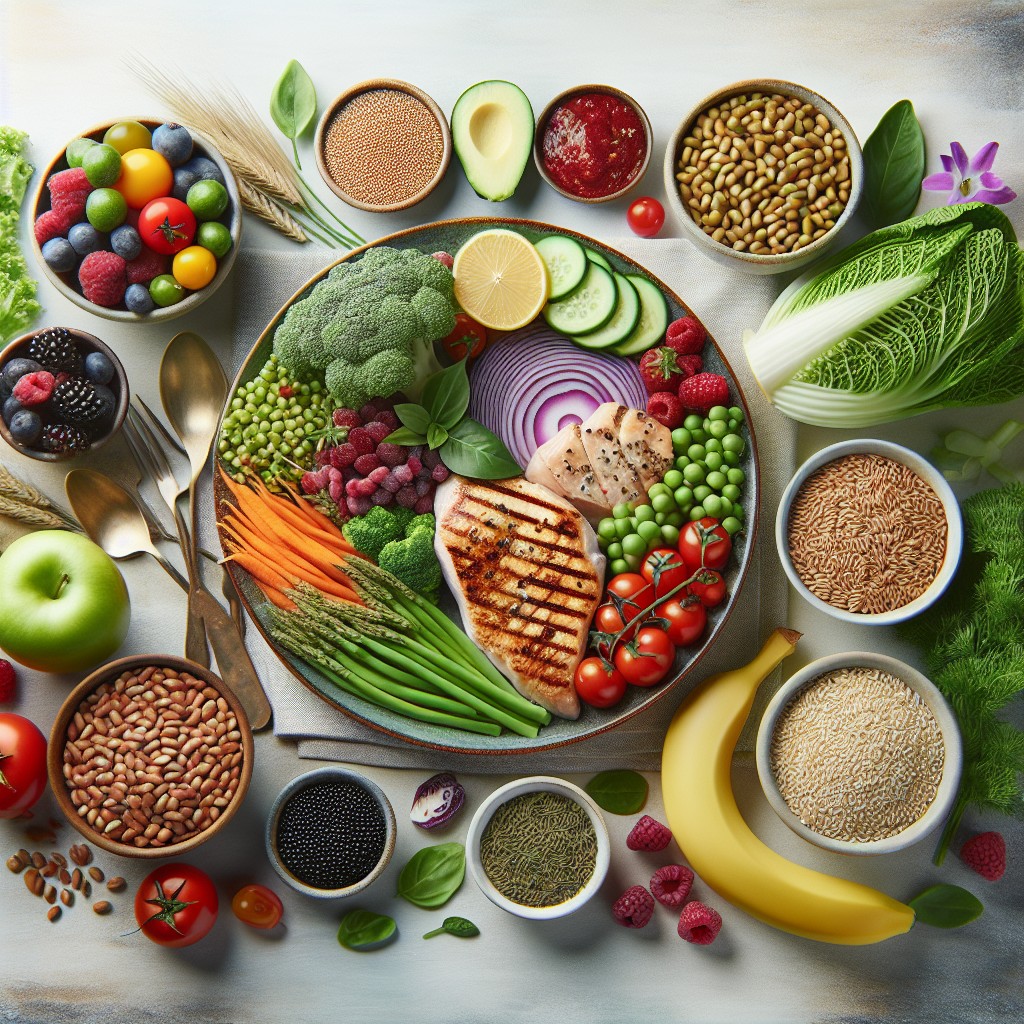Last updated on
Gettin’ My Healthy On captivates with its invigorating mix of food and lifestyle content, earning its place on your reading list because it transforms healthy living from a chore to a delightful journey.
Embarking on a health-driven lifestyle overhaul can be a transformative journey, and “Gettin’ My Healthy On” serves as an ideal companion for this voyage.
This blog is a treasure trove of insights, covering the spectrum from chronic disease prevention and mental health enhancement to the creation and maintenance of life-enriching habits.
Whether you aim to boost longevity, optimize cognitive functions, or simply elevate your day-to-day quality of life, the practical guidance on goal setting, habit stacking, and embracing setbacks will empower you.
Moreover, the blog’s focus on nutritiously rich, whole food-based eating, coupled with delectable recipes tailored for various dietary preferences, equips you with the tools for sustained well-being.
Beyond the plate, recommendations for staying physically active, upper body workout tips, and strategies for hydration and mindful eating round out a holistic approach to health.
Step into a supportive space that celebrates progress, adapts to seasonal shifts, and showcases real-life inspiration, ensuring that your healthy living blueprint is both enjoyable and enduring.
What's Inside
The Importance Of A Healthy Lifestyle

Embracing a healthy lifestyle can lead to profound changes in one’s wellbeing, from amplified energy levels to improved long-term health outcomes. Here’s a look at why prioritizing health matters:
- Chronic Disease Prevention: Healthy habits can help thwart conditions such as heart disease, diabetes, and obesity.
- Enhanced Mental Health: Regular physical activity and a balanced diet are correlated with decreased stress and anxiety levels.
- Longevity: Research suggests that those who practice healthy living tend to enjoy a longer life span.
- Quality of Life: A robust health regimen can boost one’s overall quality of life, providing more vigor for daily activities.
- Immune Function: Proper nutrition and exercise strengthen the immune system, aiding in the defense against illness.
- Cognitive Benefits: Engaging in a wholesome lifestyle also supports cognitive health, maintaining sharpness and memory as one ages.
These points underscore that adopting health-conscious practices is not just about physical appearance, but indeed encompasses a holistic approach to enhancing life quality in various domains.
Building Healthy Habits

Embarking on a journey toward well-being starts with small, manageable steps—one habit at a time. Consistency is the cornerstone of habit formation; even the smallest change, if repeated daily, can lead to significant improvements in health.
- Set achievable goals: Begin with clear, specific intentions such as adding an extra serving of vegetables to your dinner plate, aiming for a realistic goal makes it easier to stay on track.
- Cue-routine-reward cycle: Understand this pattern that forms habits. For instance, leaving workout clothes out as a cue for a morning run, followed by a healthy breakfast as a reward, can reinforce a fitness routine.
- Be patient with yourself: Change doesn’t happen overnight. Patience is crucial as habits take time to become second nature.
- Track your progress: Use a journal or an app to monitor your developments. This visual representation of your dedication can be a powerful motivator.
- Stack habits: Link a new habit to an existing one. If you already have a cup of tea every morning, try pairing it with reading nutrition labels to make more informed food choices.
- Encourage a supportive environment: Surround yourself with people who inspire and support your healthy lifestyle choices.
- Embrace setbacks as part of the process: Mistakes are inevitable. Instead of viewing them as failures, treat them as learning opportunities to strengthen your resolve.
Nourishing Your Body With Nutritious Foods
Emphasizing whole foods is key, focusing on fruits, vegetables, lean proteins, whole grains, and healthy fats. These staples deliver essential nutrients to fuel the body’s functions and support overall well-being.
Combining macro and micronutrients in each meal creates a balanced diet. Aim for a good mix of carbohydrates, proteins, and fats, along with a diverse range of vitamins and minerals.
Understanding portion control can prevent overeating while ensuring you still get enough energy and nutrients. Using smaller plates, reading labels, and listening to hunger cues can help manage portions.
Incorporating a colorful variety of foods not only makes for an attractive plate but also ensures a broad spectrum of vitamins and antioxidants, which protect the body from cellular damage.
Including probiotics and prebiotics through foods like yogurt, kefir, and high-fiber fruits and vegetables promotes a healthy gut microbiome, crucial for digestion and immune function.
Staying hydrated aids in nutrient absorption and ensures all bodily systems function optimally. While water is the best choice, other hydrating foods like cucumbers, strawberries, and watermelon also contribute to fluid intake.
Mindful eating involves being present while you eat, savoring each bite, and acknowledging how foods make you feel, which can lead to more intentional food choices and improved satiety.
Recipe Corner: Gettin My Healthy On a Food and Lifestyle Blog
The Recipe Corner section serves as a treasure trove of culinary inspiration for those seeking to energize their kitchen routine with healthy options. It features a diverse array of recipes, each thoughtfully crafted to balance taste and nutrition. From savory breakfast options to hearty, plant-based dinners and sweet but sugar-conscious desserts, there’s something to satisfy every palate while fueling your body with wholesome ingredients.
Key highlights of this section include:
- Step-by-step guides for creating meals that are both delicious and nutritious.
- Use of whole, unprocessed foods to ensure maximum health benefits.
- Options for various dietary needs, including gluten-free, vegan, and low-carb recipes.
- Emphasis on quick and easy recipes for busy lifestyles.
- Seasonal ingredients suggestions for peak flavor and nutrition.
- Interactive elements where readers can share their adaptations or successes.
Each recipe encourages experimentation and customization to cater to personal preferences, making healthy eating a creative and enjoyable process.
Fitness and Exercise
Incorporating regular physical activity into your routine can transform your health and energy levels. Aim for a mix of cardio, strength training, and flexibility exercises.
Cardiovascular workouts, like brisk walking, running, or cycling, strengthen the heart and improve lung capacity. They can be easily adjusted to your fitness level and are essential for burning calories and weight management.
Strength training, with bodyweight exercises, resistance bands, or weights, builds muscle and boosts metabolism. Muscles are great at burning calories even at rest, so more muscle equals more calories burned throughout the day.
Flexibility exercises, such as yoga or stretching, enhance joint range of motion and can prevent injuries. They also promote relaxation and stress relief.
To stay engaged with your fitness routine, try new types of workouts to prevent boredom. Group classes, online workouts, and sporting activities can keep exercise fun and socially connective.
Remember, consistency is key for long-term fitness. Even a 10 to 15-minute increment of exercise can have significant health benefits when done regularly. Listen to your body and increase intensity or duration incrementally to avoid burnout or injury.
Mindfulness and Mental Health
Cultivating mindfulness greatly enhances mental well-being. By focusing on the present moment, stress levels can decrease, leading to clearer thoughts and a greater sense of peace.
Incorporating meditation into the daily routine, even for just a few minutes, can improve concentration and emotional regulation. Journalling also serves as a powerful tool for self-reflection and processing emotions, while gratitude practices remind us to appreciate the positives in life, contributing to improved mood and outlook.
Mindful eating practices encourage a greater connection to the food we consume, often leading to healthier dietary choices. Throughout, the key is consistent practice, which reinforces these habits and integrates them into everyday life for a more balanced, healthier mental state.
Grocery Shopping and Meal Planning
Efficient grocery shopping and strategic meal planning are essential pillars in maintaining a healthy diet. Begin with a well-organized list that reflects your meal plan for the week, focusing on a variety of fresh produce, lean proteins, whole grains, and healthy fats. Aim to shop the perimeter of the store first, where fresh items are typically located, to fill your cart with nutrient-dense foods.
When planning meals, consider batch cooking and preparing ingredients ahead of time to save effort throughout the week. Choose recipes with overlapping ingredients to minimize waste and cost, while also providing a diverse menu. Embrace the use of a slow cooker or Instant Pot for time-saving, healthy cooking methods. Be mindful of portion sizes and try to plan for leftovers that can be repurposed into new meals.
Lastly, don’t forget to account for snacks – cut vegetables, fruit, and healthy dips like hummus can be prepped and stored for easy access. By committing a little time to planning and shopping, you pave the way to healthier eating habits.
Tips to Listen to Your Body
Tuning into your body’s signals is essential for maintaining balance and health. Here are actionable pointers:
- Recognize hunger cues – Eat when you’re genuinely hungry, not out of boredom or emotion.
- Identify fullness – Stop eating before you feel overfull, aiming for a comfortable satiety level.
- Assess your energy – Notice how different foods affect your vitality and adjust your diet accordingly.
- Pay attention to cravings – Cravings can signal nutritional deficiencies or emotional needs. Reflect on the underlying cause.
- Monitor sleep patterns – Quality sleep affects overall well-being. Note how dietary choices influence your rest.
- Mind the mood – Observe how food choices correlate with mood swings or changes.
- Stay hydrated – Listen for thirst signals; often, the body can mistake dehydration for hunger.
By heeding these tips, you can cultivate a more intuitive relationship with your body, enhancing your health journey.
Success Stories and Inspirational Profiles
Highlighting real-life transformations fuels motivation and showcases the impact of a balanced diet and active lifestyle. Profiles often reflect diverse backgrounds, emphasizing that health and wellness are accessible to everyone. These narratives provide practical tips that helped individuals overcome obstacles, making the journey relatable and achievable. Furthermore, before-and-after photos give a visual testament to the changes, serving as a powerful tool for inspiration. Readers are encouraged to share their own stories, creating a community of accountability and support.
Complete Upper Body Workout
Strength training is integral to a balanced fitness routine, focusing on building muscle and enhancing overall health. For a well-rounded upper body workout, aim to target the major muscle groups: the chest, back, shoulders, biceps, and triceps.
Here’s how you can structure your routine:
1. Start with compound exercises: These are movements that work multiple muscle groups simultaneously, such as push-ups, pull-ups, and bench presses. They are efficient and burn more calories.
2. Incorporate isolation moves: Exercises like bicep curls and tricep dips focus on individual muscle groups, helping to correct imbalances and refine muscle tone.
3. Ensure balanced training: Alternating between pushing and pulling exercises can help prevent posture issues and muscle imbalances.
4. Be mindful of form: Proper technique prevents injury and ensures you’re engaging the right muscles. If new to these exercises, consider consulting a professional.
5. Use progressive overload: Gradually increase the weight or resistance to continue challenging your muscles and to promote growth.
6. Remember to rest: Muscles need time to recover. Allow at least 48 hours before working the same muscle groups again.
Incorporate these tips consistently into your fitness regimen for a stronger, more resilient upper body over time.
Daily Themes for Easier Meal Planning
Establishing daily themes simplifies the meal-planning process by creating a predictable structure that can reduce decision fatigue. Here are some thematic ideas:
- Meatless Monday: Embrace plant-based meals to start the week, such as bean-based chili or lentil curry.
- Taco Tuesday: Get creative with tacos, from traditional carne asada to fish or vegetarian options.
- World Cuisine Wednesday: Explore international dishes, maybe Thai stir-fries or Italian pastas.
- Throwback Thursday: Recreate old family favorites or classic dishes from your childhood.
- Fish Friday: Incorporate heart-healthy seafood, trying recipes like grilled salmon or fish tacos.
- Slow Cooker Saturday: Save time with set-and-forget meals like stews or pulled pork.
- Soup and Salad Sunday: Prepare for the week with light, easy dishes like a hearty vegetable soup or a chicken Caesar salad.
Rotating these themes provides variety while maintaining the simplicity needed to stick to a meal plan.
What I Learned From Adopting an Early Morning Routine
Adopting an early morning routine brought unexpected benefits that echoed throughout the day. Waking up before the sun fostered a sense of quietude, allowing for uninterrupted reflection and planning. This precious ‘me-time’ created a strong foundation for productivity, offering a head start to tackle the day’s tasks.
The early hours became a sanctuary for exercise, a time when the world felt still, and the streets, less crowded. Physical activity upon rising helped to jumpstart the metabolism and infuse the day with energy.
With the early morning wake-up call also came the gift of time—a breakfast that was mindful and nourishing rather than rushed. This change cultivated better eating habits and decision-making about food throughout the day.
Embracing the morning light, often overlooked, surprisingly had profound effects on sleep patterns. Exposure to natural light helped to regulate the sleep-wake cycle, leading to more restful nights and a decrease in sleep-related issues.
The discipline instilled by rising early rippled into other areas of life, promoting better organization, time management, and a heightened sense of accomplishment. It led to a domino effect of positive changes, underlining the power of a consistent morning routine.
Eat Mindfully
When dining, it is crucial to be present both mentally and physically. Here are a few strategies to enhance your eating experience:
- Chew slowly: Take time with each bite to savor the flavors and textures, aiding digestion and satisfaction.
- Eliminate distractions: Turn off electronics to better focus on your meal and recognize your body’s hunger and fullness signals.
- Portion Control: Serve your meals on smaller plates to help manage portion sizes and reduce overeating.
- Practice gratitude: Appreciate your food by thinking about its sources and the effort taken to prepare your meal. This can lead to a deeper sense of contentment with your food choices.
- Listen to your body: Recognize your hunger cues and eat when you’re truly hungry, not out of boredom or emotion. Stop eating when you’re comfortably full, not stuffed.
- Savor your food: Pick foods that are both nourishing and enjoyable, so eating becomes a satisfying experience rather than a rushed task.
Move More
Incorporating physical activity into your daily routine doesn’t require significant chunks of time or a gym membership. Small changes can lead to big results over time. Consider taking the stairs instead of the elevator, having a dance party while doing household chores, or going for a brisk walk during your lunch break. It’s about finding enjoyable ways to stay active—perhaps it’s cycling, joining a local sports team, or doing yoga. Remember, consistency is key; it’s better to exercise a little every day than to have one marathon session once a week. Aim to set realistic goals that increase your movement incrementally, and watch as your energy levels and overall well-being improve.
Drink Lots of Water
Staying hydrated is crucial for maintaining optimal health and vitality. Water is essential in facilitating various bodily functions including digestion, absorption, circulation, and temperature regulation.
Here are practical tips to ensure you’re drinking enough:
- Keep a Bottle Handy: Carry a reusable water bottle so you can sip throughout the day.
- Flavor Your Water: If you find plain water boring, add a splash of flavor with lemon, cucumber, or berries.
- Eat Water-Rich Foods: Incorporate fruits and vegetables like watermelon, cucumber, and grapefruit into your diet.
- Set a Reminder: Use your phone or smartwatch to remind you to take hydration breaks.
- Monitor Your Intake: Track how much water you drink daily to meet your personal hydration goals.
- Pay Attention to Your Body: Thirst is the body’s request for water; answer it promptly.
Continue reading:



